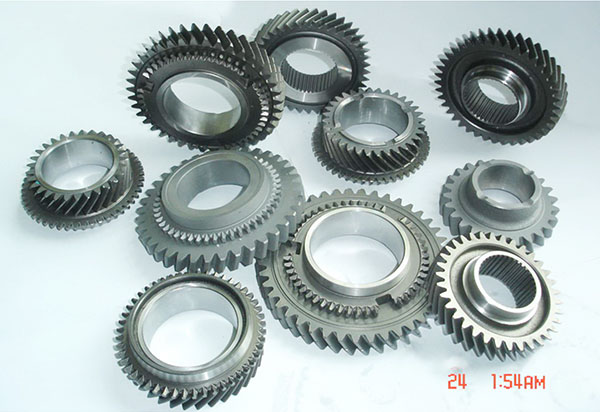Professional manufacturer of automobile transmission gears, mechanical engineering gears, engine gears, light and heavy trucks, and truck transmission gears.
The Heart of Your Vehicle: Understanding the Automotive Transmission
Update time:2023/09/06
The Significance of the Automotive Transmission
Imagine a car without a transmission, where the engine's power is directly linked to the wheels. It would be challenging to manage speed, maneuver through traffic, or achieve good fuel efficiency. The automotive transmission solves these problems by allowing the engine to operate efficiently across a wide range of speeds while providing the driver with control over the vehicle's movement.
Types of Automotive Transmissions
Manual Transmission: Also known as a stick shift, this type of transmission requires the driver to manually engage and disengage gears using a clutch pedal. Manual transmissions offer more control over the vehicle's power delivery and can be more fuel-efficient if driven skillfully.
Automatic Transmission: In contrast to manual transmissions, automatic transmissions shift gears without driver intervention. They use a torque converter to manage the connection between the engine and the wheels. Automatic transmissions are popular for their convenience and ease of use, making them prevalent in many vehicles today.
Continuously Variable Transmission (CVT): CVTs do not use traditional gears but instead employ a system of pulleys and belts to provide a continuous range of gear ratios. This design allows for smoother acceleration and improved fuel efficiency. CVTs are commonly found in modern compact and hybrid vehicles.
The Role of the Transmission
The automotive transmission serves several critical functions:
Gear Shifting: The transmission allows the driver to switch between different gear ratios, matching the engine's power output to the vehicle's speed and load. This enables the vehicle to accelerate, climb hills, and maintain cruising speed efficiently.
Reverse Gear: The transmission provides a reverse gear, allowing the vehicle to move backward when needed.
Neutral Position: In this setting, the transmission disengages from the engine, allowing the wheels to spin freely without applying engine power. This is essential for towing or when the vehicle needs to be pushed or pulled.
Park: The transmission's park setting locks the wheels in place, preventing the vehicle from moving. It's crucial for keeping the vehicle stationary when parked.
Transmission Maintenance and Care
To ensure the longevity and optimal performance of your vehicle's transmission, it's essential to follow a few maintenance and care guidelines:
Regular Fluid Checks: Transmission fluid plays a crucial role in cooling and lubricating the transmission. Regularly check the fluid level and condition, and replace it as recommended by the vehicle manufacturer.
Prevent Overheating: Overheating can damage the transmission. Avoid towing heavy loads in hot weather or using the vehicle for extended periods of heavy-duty driving without proper cooling.
Gentle Driving: Aggressive driving, such as rapid acceleration and abrupt braking, can strain the transmission. Drive smoothly to reduce wear and tear.
Regular Inspections: Have your transmission inspected by a qualified mechanic periodically to detect and address any potential issues early.

Imagine a car without a transmission, where the engine's power is directly linked to the wheels. It would be challenging to manage speed, maneuver through traffic, or achieve good fuel efficiency. The automotive transmission solves these problems by allowing the engine to operate efficiently across a wide range of speeds while providing the driver with control over the vehicle's movement.
Types of Automotive Transmissions
Manual Transmission: Also known as a stick shift, this type of transmission requires the driver to manually engage and disengage gears using a clutch pedal. Manual transmissions offer more control over the vehicle's power delivery and can be more fuel-efficient if driven skillfully.
Automatic Transmission: In contrast to manual transmissions, automatic transmissions shift gears without driver intervention. They use a torque converter to manage the connection between the engine and the wheels. Automatic transmissions are popular for their convenience and ease of use, making them prevalent in many vehicles today.
Continuously Variable Transmission (CVT): CVTs do not use traditional gears but instead employ a system of pulleys and belts to provide a continuous range of gear ratios. This design allows for smoother acceleration and improved fuel efficiency. CVTs are commonly found in modern compact and hybrid vehicles.
The Role of the Transmission
The automotive transmission serves several critical functions:
Gear Shifting: The transmission allows the driver to switch between different gear ratios, matching the engine's power output to the vehicle's speed and load. This enables the vehicle to accelerate, climb hills, and maintain cruising speed efficiently.
Reverse Gear: The transmission provides a reverse gear, allowing the vehicle to move backward when needed.
Neutral Position: In this setting, the transmission disengages from the engine, allowing the wheels to spin freely without applying engine power. This is essential for towing or when the vehicle needs to be pushed or pulled.
Park: The transmission's park setting locks the wheels in place, preventing the vehicle from moving. It's crucial for keeping the vehicle stationary when parked.
Transmission Maintenance and Care
To ensure the longevity and optimal performance of your vehicle's transmission, it's essential to follow a few maintenance and care guidelines:
Regular Fluid Checks: Transmission fluid plays a crucial role in cooling and lubricating the transmission. Regularly check the fluid level and condition, and replace it as recommended by the vehicle manufacturer.
Prevent Overheating: Overheating can damage the transmission. Avoid towing heavy loads in hot weather or using the vehicle for extended periods of heavy-duty driving without proper cooling.
Gentle Driving: Aggressive driving, such as rapid acceleration and abrupt braking, can strain the transmission. Drive smoothly to reduce wear and tear.
Regular Inspections: Have your transmission inspected by a qualified mechanic periodically to detect and address any potential issues early.


 简体中文
简体中文 English
English España
España Русский язык
Русский язык











